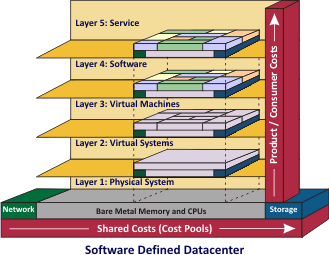Service Consolidation
The movement toward
Software Defined
Datacenters is forcing IT to
become a Hosted Service
Provider. While the costs of
IT are decreasing, the
process of defined cost
allocation is becoming
more complex.
Shared Resources
Effective cost allocation of
shared resources requires
a comprehensive and
continuous stream of
system performance data.
This data is used to identify
usage by consumer and/or
product, and is required for
the accurate allocation of
costs.
Cost Perspectives
Each business has a unique
set of cost drivers based
on Financial and
Operational needs. This
business centric
information must be
included in the cost
allocation model so that a
“fair market price” is
calculated for the business
consumer or product.
What is IT Cost Transparency?
Simply put, it is a measure of the value of
IT services being provided to the
business. Financial, operational, and
performance data is integrated in a
manner that determines the total cost of
individual IT services. The net result is
the ability to link IT service costs to the
business’s consumers and products.
While simply defined, the ability to
identify and link individual IT service
costs to the business is becoming more
complex. The movement toward Software
Defined Datacenters (and the like) is
transforming IT operations into an
environment that resembles that of a
managed hosting business. With the
sharing of IT resources (both physical and
human), the “identification” of IT service
usage by the business consumer is
becoming progressively more muddled
and requires an intelligent approach for
targeted cost allocation.
Business Consumer Information
The continuing server consolidation movement has resulted in reduced IT service costs, but there has
been a price to pay: The inability to identify and link individual IT service cost to the business. As the
limit to cost reduction is approached by IT operations, there is a greater need to link IT service costs
to the consumers of those resources. In the future, the IT consumers will have the greatest ability to
control IT service costs, and will do so by making smarter use of IT resources.
Within a hosted environment, the cost of IT resources (expenses) must be fairly applied to the
delivered services. However, there are other costs and data (both financial and operational) that
must be included for comprehensive cost metrics. Finally, a business framework must be established
that defines the key business drivers and metrics required for each stakeholder and consumer.
Shared Horizontal Cost
A hosted IT environment includes many costs used for the common purpose of delivering IT services.
These costs can be direct or indirect in nature, and can include capital assets as well as annual
operational budgets. This situation is further complicated in that different consumers generally need
and use resources differently.
Unfortunately, there is no one-to-one relationship between the IT costs and the business
consumer. In today’s IT operations, most (if not all) costs are shared. To achieve Cost Transparency,
an intelligent approach is required to identify the consumption of shared IT resources (both physical
and human), and to determine the fair cost of that consumption. The means and measures of that
cost calculation must be provided to the consumer in the form of a Bill of IT or other similar
deliverable.
Consumer Vertical Cost
The total cost of a delivered IT service does not consist of a single value, but rather a series of value
calculations based on consumer constraints. This process is further complicated in that the calculation
is context sensitive. That is to say, for the calculation to be accurate it must also consider other
processing that is used in support of the consumer processing (i.e. shared databases, web servers,
etc.).
For example, in a Software Defined Datacenter a single consumer instance could be defined by a
Virtual Machine (VM). For this VM, the defined period cost would be determined by the sum of three
calculations that are repeated for each hour of the day. The first calculation (Layer 3) is to assign its
share of the underlying physical system cost (physical memory, cpu, network, and storage). The
second calculation (Layer 4) adds in the shared costs of software and related charges. This
calculation may be complicated by the need to include other shared resources (i.e. database, web
server, etc.) that were provided to the consumer processing. The final calculation (Layer 5) adds in
the cost of external resources (i.e. help desk, IT management, etc.), and could also include consumer
related costs that are linked to the IT services.


